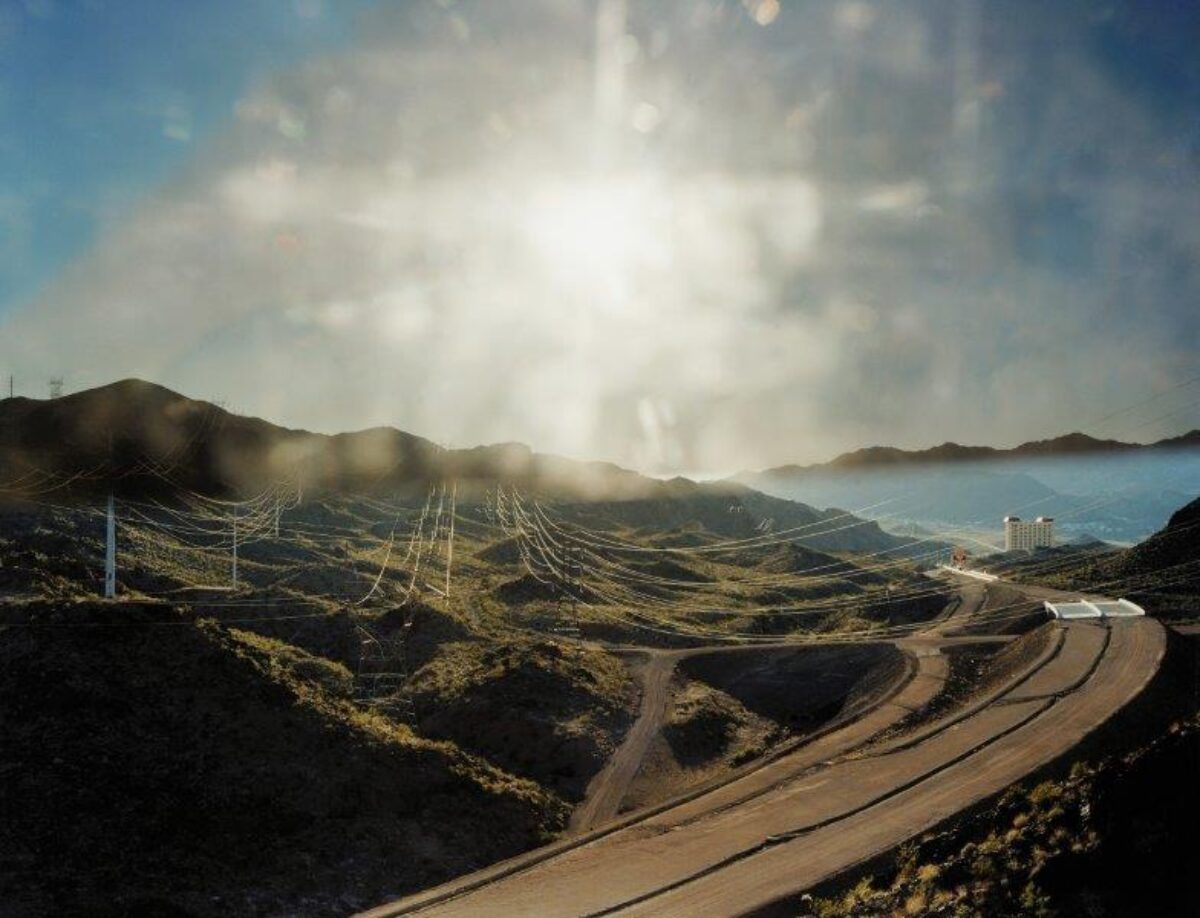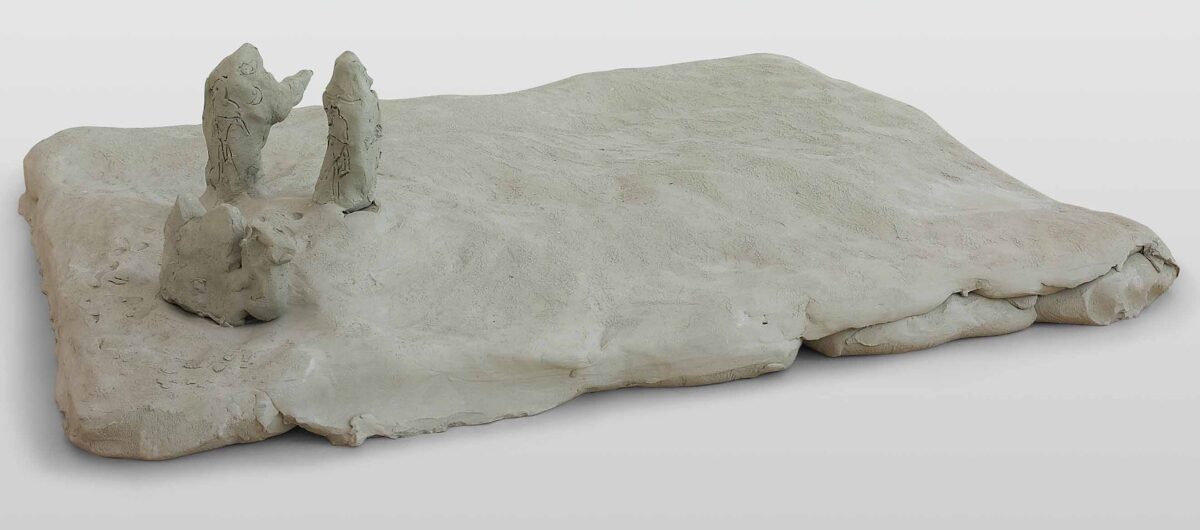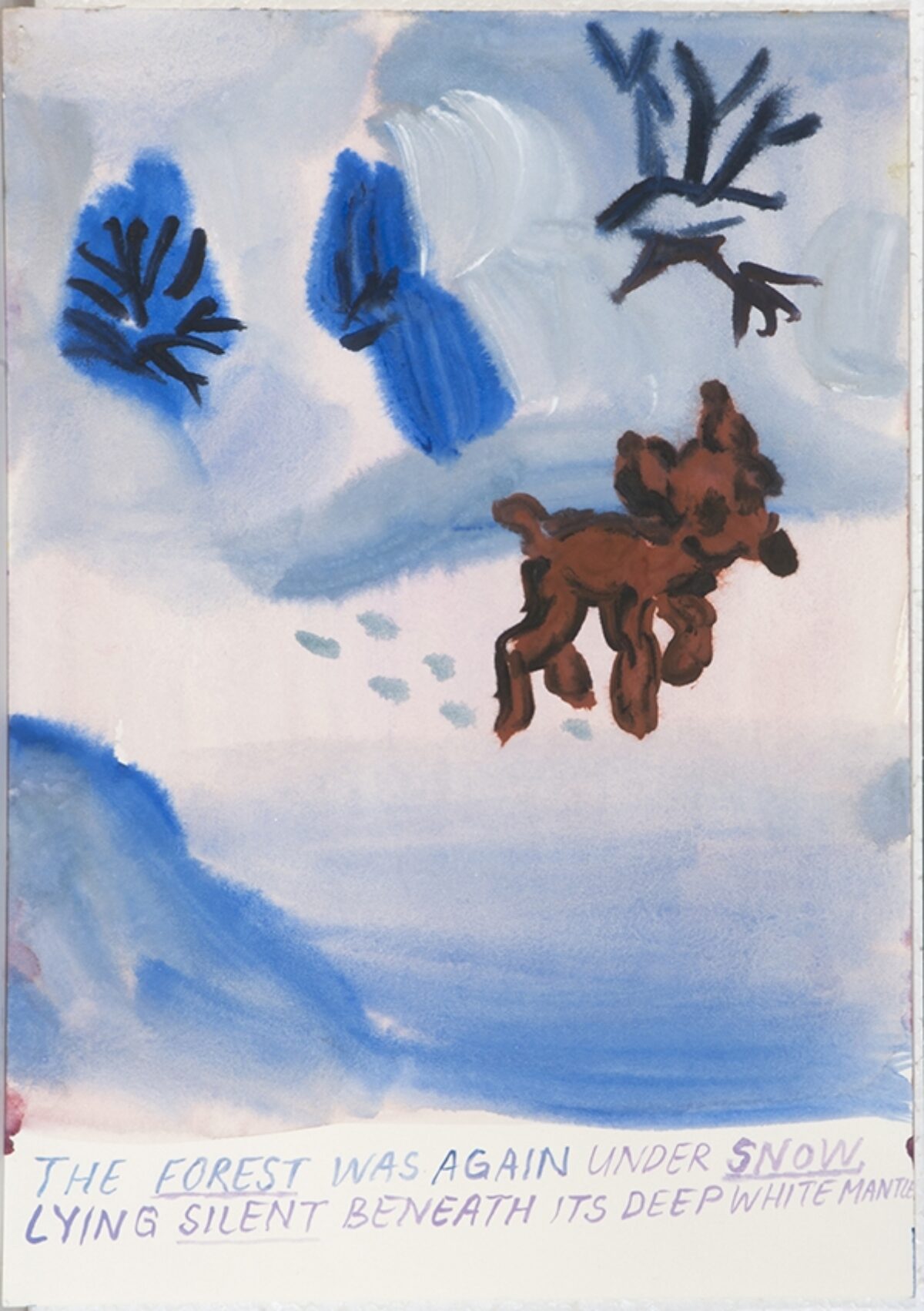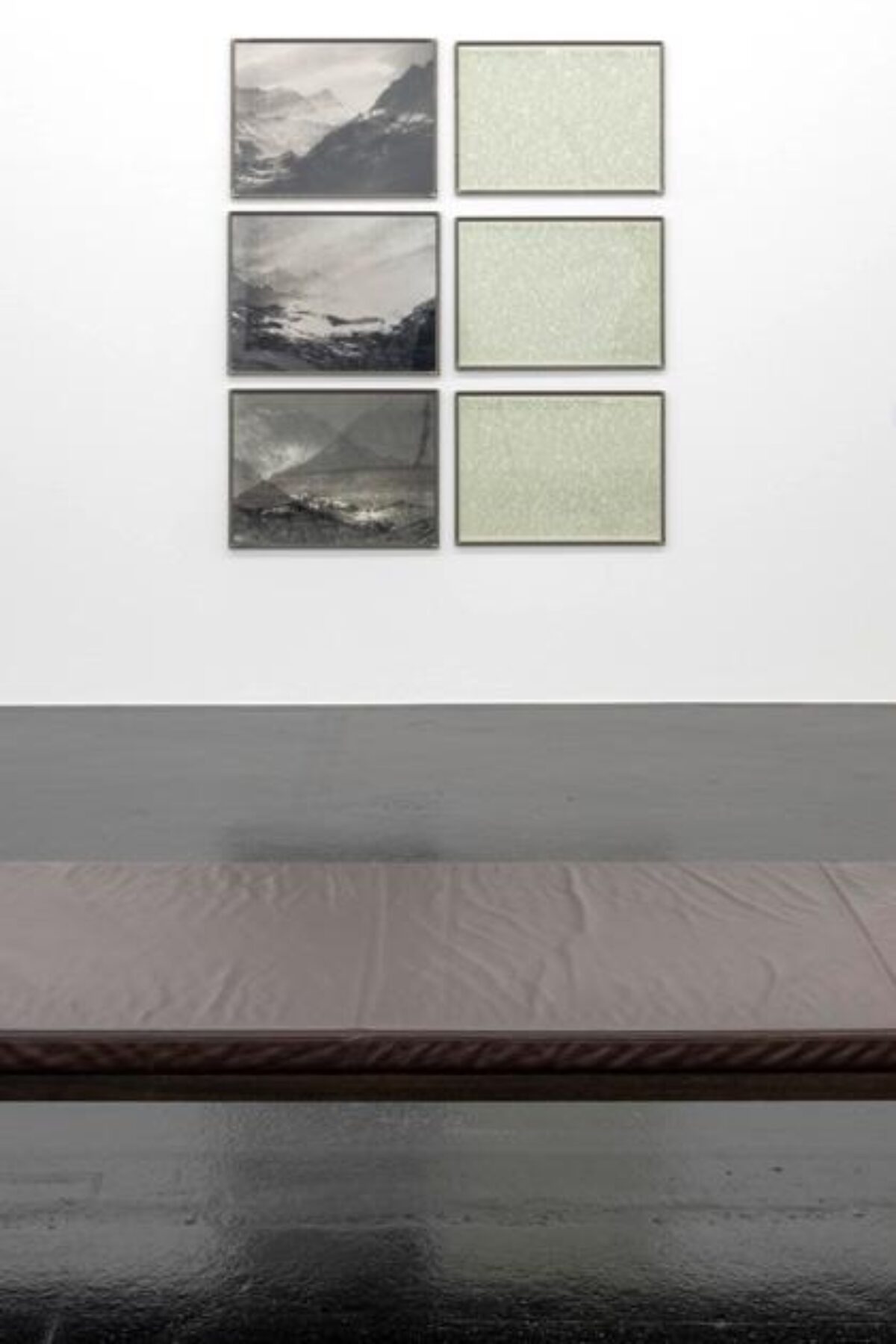
Verschiedene Materialien, 2 Röhrenmonitore, 2 Abspielgeräte, 3000 x 1380 x 2267 cm, Installation
English, french and italian version below
„Wirtschaftslandschaft Davos“ ist vor zwanzig Jahren entstanden, anlässlich des Preises der Zürcher Kunstgesellschaft an Thomas Hirschhorn (*1957). Damals war das Werk im Zürcher Kunsthaus erstmals zu sehen und wurde als Neuankauf 2011 in Aarau zum zweiten Mal ausgestellt. Die Arbeit ist ein Meilenstein in Thomas Hirschhorns Schaffen und es ist bedeutend, dass sie für eine öffentliche Schweizer Sammlung gesichert werden konnte. Dies wurde dank einem massgeblichen Beitrag der Eidgenössischen Kunstkommission, des Aargauer Kunstvereins und weiterer Geldgeber möglich.
„Wirtschaftslandschaft Davos“ ist ein überwältigendes Werk. Die ausufernde, begehbare Skulptur besteht aus verschiedenen Bereichen: der zentralen Modelllandschaft des winterlichen Davos, einem Rundgang mit Archivmaterialien, einem Podest mit Originalwerken von Ernst Ludwig Kirchner und Hermann Scherer und einem Kinosaal, in dem Rolf Lyssys Film „Konfrontation“ von 1975 gezeigt wird.
Mit der Schilderung einer Berglandschaft ist die Arbeit eingebettet in ein grosses Thema der abendländischen und speziell in der Schweizer Kunst. Die alpine Landschaft ist ein Motiv mit grosser Tradition − auch in der Aargauer Sammlung −, die von Caspar Wolf über Ferdinand Hodler bis zu Balthasar Burkhard reicht. Bei Thomas Hirschhorn geht es aber nicht um die unberührte Natur, denn die Landschaft interessiert ihn als sozialer, politischer, ökonomischer Raum, als Bühne für den Menschen und die Zivilisation: Die Landschaft Davos wird in all ihren Facetten und als Ort voller Gegensätze dargestellt. So thematisiert der Künstler beispielsweise den historischen Kurort, der Thomas Mann als Kulisse für seinen 1000-seitigen Roman Der Zauberberg diente oder Davos als beliebte Tourismusstation und Heimat des HC Davos. Die Region war während rund 20 Jahren auch der Wohn- und Schaffensort von Ernst Ludwig Kirchner. Seine Bilder prägen unsere Vorstellung der Prättigauer Landschaft und Schweizer Künstler, vornehmlich aus Basel, pilgerten zum Deutschen Expressionisten und wurden seine Schüler. So auch Hermann Scherer. Thomas Hirschhorn bindet diesen Aspekt in seine Arbeit ein, indem er Originalwerke von Kirchner und Scherer auf geschickte Weise eingegliedert.
Alle angesprochenen Themen und viele mehr integriert Thomas Hirschhorn in seine „Wirtschaftslandschaft Davos“, indem er eine Fülle von Materialien, Texten, Bildern oder Büchern ausbreitet und die Betrachtenden einlädt, sich in die Materie zu vertiefen. Mit dem Film von Rolf Lyssy kommt ein weiteres Thema dazu, nämlich die dunklen Spuren, die der Nationalsozialismus in Davos hinterlassen hat. Es war Rückzugsort und Kurort für Menschen verschiedenster Couleur, so auch vom NSDAP-Gauleiter Wilhelm Gustloff, der dann − wie im Film geschildert − dort erschossen wurde.
Thomas Hirschhorn zeigt Davos im Winter und zwar während der Austragung des World Economic Forums. Der Ort ist unter Belagerung, in einem Ausnahmezustand. Polizei- und Militärkräfte sind in Position gebracht um das Treffen der Mächtigen dieser Welt vor Attacken zu schützen. Ein riesiges Spektrum an ungelösten Fragen trifft aufeinander, die Gegensätze der Welt begegnen sich. Davos wird zur Bühne der Weltkonflikte und damit zur Hochsicherheitszone.
Was die Stärke von Thomas Hirschhorns Arbeit ausmacht, ist seine Gabe, die Dinge nie zu vereinfachen. Es geht ihm nicht um klare Statements, nicht ums „auf den Punkt bringen“. Diesen „Punkt“ entlarvt er als Fiktion. Er zeigt die Themen auf in ihrer ganzen Komplexität und Widersprüchlichkeit und darin besteht die Herausforderung für die Rezipienten seiner Arbeit. Wir müssen eintauchen, uns auseinander setzten. Der Künstler klagt an, zeigt auf, bietet aber keine Lösungen an. Darin liegt die Provokation und die Verunsicherung, die sein Werk auslöst. Er mischt sich ein, zeigt seine Befürchtungen, stellt sich gegen die Gleichgültigkeit. Und er lässt uns teilhaben an diesem Prozess. Thomas Hirschhorn schafft mit seiner Arbeit eine Plattform, ein Feld, das als Ort der Konfrontation und des Dialogs angelegt ist. Die Arbeit ist genauso komplex und schwierig wie es unsere Welt auch ist.
Madeleine Schuppli
***
“The Davos Economic Landscape” was created twenty years ago when the Prize of the Zurich Art Society was awarded to Thomas Hirschhorn (b. 1957). At the time, the work was first presented at Kunsthaus Zürich, and in 2011 it was exhibited a second time as a new acquisition at the Aargauer Kunsthaus. The work is a milestone in Thomas Hirschhorn’s oeuvre, and it is significant that it could be secured for a Swiss public collection. This was made possible in part through generous additional funding by the Swiss Federal Art Commission, the Aargau Art Association and other donors.
“The Davos Economic Landscape” is an overwhelming work. The sprawling, walkable sculpture consists of different sections: the central model landscape of wintry Davos, a gallery with archival material running around it, a dais with original works by Ernst Ludwig Kirchner and Hermann Scherer and a cinema room where Rolf Lyssy’s 1975 film “Assassination in Davos” (“Konfrontation”) is screened.
In depicting a mountain landscape, the piece draws on a grand theme of Western and especially Swiss art. The Alpine landscape is a subject with a great tradition – one also reflected in the collection of the Aargauer Kunsthaus – from Caspar Wolf to Ferdinand Hodler to Balthasar Burkhard. But in the work of Thomas Hirschhorn the focus is not on unspoilt nature; what interests him is the landscape as social, political, economic space, as a stage for humankind and civilisation. The Davos landscape is presented in all its facets and as a place full of contrasts. The artist considers the historical spa town which provided the setting for Thomas Mann’s 1000-page novel “The Magic Mountain”, just as he addresses Davos as the popular tourist destination and home of the HC Davos hockey club. Ernst Ludwig Kirchner also lived and worked in the region for about 20 years. His paintings shape the image we have of its landscape, and Swiss artists from Basel in particular made pilgrimages to the German Expressionist and became his students, among them Hermann Scherer. Thomas Hirschhorn incorporates this aspect into his work by cleverly incorporating original works by Kirchner and Scherer.
Thomas Hirschhorn integrates all aforementioned topics and many more into “The Davos Economic Landscape” by spreading out a wealth of materials, texts, pictures and books and inviting viewers to delve into the subject. The film by Rolf Lyssy adds another topic: the dark stamp National Socialism left on Davos. It was a refuge and health resort for all kinds of people, including Wilhelm Gustloff, the leader of the Swiss branch of the NSDAP, who ended up being shot and killed there, as depicted in the film.
Thomas Hirschhorn shows Davos in winter at the time the World Economic Forum is held there. The place is under siege, in a state of emergency. Police and military forces are in position to protect the gathering of the world’s powerful from attacks. A wide range of unresolved issues collide, the opposites of the world meet. Davos becomes a stage for world conflicts and, as a result, a high-security zone.
What makes Thomas Hirschhorn’s work so powerful is his talent to never simplify things. It is not about clear statements, not about “getting to the heart of things”. He exposes this “heart” as a myth. The issues are presented in all their complexity and contradictions and therein lies the challenge for the viewers of his work. We are forced to delve in and reflect. The artist denounces, points out, but does not offer solutions. This is what makes his work provocative and unsettling. He involves himself, presents his concerns, opposes indifference. And he lets us participate in this process. Hirschhorn creates a platform, a field conceived as a place of confrontation and dialogue. The piece is just as complex and complicated as our world is.
Madeleine Schuppli
***
«Wirtschaftslandschaft Davos» a été réalisé il y a vingt ans à l’occasion du prix de la Zürcher Kunstgesellschaft décerné à Thomas Hirschhorn (*1957). A l’époque, l’œuvre fut d’abord présentée au public au Zürcher Kunsthaus, avant d’être exposée une seconde fois à Aarau en 2011 lors de son acquisition. Constituant un jalon dans la création de Thomas Hirschhorn, il était capital que ce travail puisse entrer dans une collection publique suisse. Ceci est devenu possible grâce à une contribution significative de la Commission fédérale d’art, de l’Aargauer Kunstverein et d’autres mécènes.
«Wirtschaftslandschaft Davos» est une œuvre impressionnante. L’installation monumentale, que l’on peut parcourir, se compose de différentes zones: le paysage central en modèle réduit du Davos hivernal, un parcours avec du matériel d’archives, une estrade avec des œuvres originales d’Ernst Ludwig Kirchner et Hermann Scherer ainsi qu’une salle de cinéma dans laquelle on peut visionner le film de Rolf Lyssy de 1975 «Konfrontation».
Décrivant un paysage montagnard, l’œuvre s’inscrit dans un grand thème de l’art occidental et plus spécialement suisse. Le paysage alpin est un motif de longue tradition – également dans les collections de l’Aargauer Kunsthaus – allant de Caspar Wolf à Balthasar Burkhard en passant par Ferdinand Hodler. Chez Thomas Hirschhorn, il n’est toutefois pas question de nature intacte, car la nature l’intéresse en tant qu’espace social, politique, économique, en tant que scène pour l’Homme et la civilisation: le paysage de Davos est représenté sous toutes ses facettes et comme lieu plein de contradictions. Ainsi, l’artiste thématise aussi bien le lieu de cure historique, qui servit de coulisse à Thomas Mann pour son roman de mille pages «La Montagne magique», que Davos en tant que station touristique recherchée et pays du HC Davos. La région fut également durant une vingtaine d’années le lieu de résidence et de création d’Ernst Ludwig Kirchner. Ses tableaux façonnent notre idée des paysages du Prättigau et des artistes suisses, surtout de Bâle, rendaient visite à l’expressionniste allemand et devinrent ses élèves, dont notamment Hermann Scherer. Thomas Hirschhorn intègre ces aspects dans son travail en insérant habilement des œuvres originales de Kirchner et de Scherer.
Thomas Hirschhorn réunit tous ces thèmes, et bien d’autres, dans son «Wirtschaftslandschaft Davos», en déployant une multitude de matériaux, textes, images et livres, et en invitant les spectateurs à se pencher sur le sujet. Avec le film de Rolf Lyssy vient s’ajouter un autre thème, à savoir les traces sombres que le national-socialisme a laissées à Davos qui fut un refuge et un lieu de cure pour des personnes aux opinions politiques les plus diverses. Parmi eux le chef de la section suisse du NSDAP, Wilhelm Gustloff, qui y fut assassiné.
Thomas Hirschhorn montre Davos en hiver, alors que se tient le World Economic Forum. Placée sous haute surveillance, la ville est en état de siège. La police et l’armée ont pris position pour protéger le rendez-vous des puissants de ce monde contre d’éventuelles attaques. Un immense spectre de questions non résolues s’affronte, les contradictions du monde se rencontrent. Davos devient la scène des conflits mondiaux et, ainsi, une zone de haute sécurité.
Ce qui fait la force du travail de Thomas Hirschhorn est son talent à ne jamais simplifier les choses. Pour lui, il ne s’agit pas de faire des déclarations claires, d’en venir à l’essentiel. Cet essentiel, il le démasque comme fiction. Il montre les thèmes dans toute leur complexité et contradiction et c’est là que se situe le défi pour les récepteurs de son travail. Nous devons nous plonger dans le sujet, nous interroger, nous remettre en question. L’artiste dénonce, pointe, mais ne propose pas de solution, ce qui explique la provocation, la perplexité que son œuvre suscite. Il s’engage, exprime ses craintes, s’oppose à l’indifférence. Et il nous associe à ce processus. Avec son installation, Thomas Hirschhorn crée une plateforme, un champ conçu comme lieu de confrontation et de dialogue. L’œuvre est tout aussi complexe et difficile que notre monde.
Madeleine Schuppli
***
Wirtschaftslandschaft Davos è un’opera imponente. La tentacolare scultura percorribile si compone di varie parti: il plastico centrale di Davos in inverno, un percorso con materiali d’archivio, uno spazio rialzato con opere originali di Ernst Ludwig Kirchner e Hermann Scherer e una sala cinematografica che ospita la proiezione del lungometraggio Konfrontation (1975) di Rolf Lyssy.
La raffigurazione di un paesaggio alpino si inscrive in una tematica fondamentale dell’arte occidentale, in particolare dell’arte svizzera. Il motivo vanta una grande tradizione – anche in seno alla collezione dell’Aargauer Kunsthaus – che si estende da Caspar Wolf a Ferdinand Hodler, fino a Balthasar Burkhard. La posta in gioco, tuttavia, non è la natura incontaminata: Hirshhorn, al contrario, si interessa al paesaggio come spazio sociale, politico ed economico, come palcoscenico per l’uomo e la civiltà. Il paesaggio di Davos è infatti raffigurato in tutte le sue sfaccettature e come luogo ricco di contrasti. Hirshhorn tematizza per esempio la storica stazione termale che ha fatto da sfondo a La montagna incantata, il romanzo di Thomas Mann lungo mille pagine, oppure l’apprezzata meta turistica e la patria dell’HC Davos. Per oltre un ventennio la regione è stata anche il luogo di residenza e attività di Ernst Ludwig Kirchner, i cui dipinti hanno segnato la nostra immagine del paesaggio della Prettigovia. Diversi artisti svizzeri, soprattutto di Basilea, si recavano in pellegrinaggio dall’espressionista tedesco e diventarono suoi allievi; uno di questi fu Hermann Scherer. Hirshhorn evoca queste vicende includendo abilmente nel proprio lavoro anche opere originali di Kirchner e Scherer.
I temi menzionati e molti altri ancora sono integrati da Hirshhorn in Wirtschaftslandschaft Davos per mezzo di un gran numero di materiali, testi, immagini e libri, che invitano lo spettatore ad addentrarsi nella materia. Il film di Rolf Lyssy chiama in gioco un tema ulteriore, ossia le tracce oscure lasciate a Davos dal nazionalsocialismo. Quale rifugio e stazione climatica, la cittadina ha accolto personaggi di ogni sorta, compreso Wilhelm Gustloff, capo della sezione svizzera del partito nazionalsocialista, ucciso a Davos, come racconta il film.
Thomas Hirschhorn propone Davos in inverno, più precisamente nei giorni del World Economic Forum. La città è assediata, in stato di emergenza. Le forze dell’ordine e militari sono dispiegate ovunque per proteggere l’appuntamento degli uomini più potenti del mondo. Un immenso spettro di domande senza risposta si scontrano, le contraddizioni del mondo si incontrano. Davos diventa scenario dei conflitti mondiali e come tale una zona ad alta sicurezza.
L’opera trae la sua forza dalla capacità dell’artista di non semplificare mai le cose. Non è sua intenzione formulare affermazioni certe né arrivare “dritto al punto”. L’intento è piuttosto quello di smascherare la finzione di qualsiasi “punto”. Hirshhorn presenta i suoi temi in tutta la loro complessità e contraddittorietà e proprio in questo risiede la sfida che propone ai fruitori delle sue opere. Dobbiamo addentrarci e affrontare il confronto. Hirshhorn denuncia, mette a nudo, senza però offrire soluzioni. Da qui la provocazione e il disorientamento implicati dal suo lavoro. L’artista si immischia, svela le sue preoccupazioni, si oppone all’indifferenza. E ci rende partecipi di questo processo. Con i suoi lavori Hirshhorn crea una piattaforma, un campo, inteso come luogo di confronto e di dialogo. I suoi lavori sono complessi e difficili come il mondo in cui viviamo.
Madeleine Schuppli

















































